When we decided to breed alpacas, I was excited. I mean more excited than I have been for virtually anything else in my life. When I first met alpacas, I fell hopelessly in love with them, and I knew I wanted to dedicate significant time to raising them.
What I didn’t know was farming is hard. Physically and emotionally, but the emotional toll is far greater than I expected. It comes with the highs of a new healthy baby to the lows of losing a favorite alpaca to an unexpected illness.
I’ve cried more times than I’d like to admit over our alpaca herd, and I know my tears are far from over. I cried as I held Zinfandel’s head as we said goodbye to her dying body, I cried as I sat with Reba and we mourned the death of her breeched baby, and I cried as I walk away from leaving Ariana at her new home. I pretty much cry every time we sell an alpaca and they leave the farm, and I’m not an emotional person or one that cries often.
I start this educational post with the statement farming is hard because breeding alpacas isn’t for everyone. I want people to understand that entering the business of alpaca farming isn’t all about show ribbons and kisses. There are lots of other activities no one ever talks about.
But that all said, would I take back my decision? Not for a moment. I’ve loved every minute of alpaca farming – tears and all.
I simply want people to go into the process of breeding alpacas with eyes wide open. It’s better for them and it is better for the health and welfare of the animals they will raise.
Decide if Breeding Alpacas is Right for You and Your Farm
Not everyone is cut out for the life of livestock breeding. It takes time, money, patience, and lots of other things I didn’t know even existed.
Before you decide if raising and breeding alpacas are right for you and your farm, I’d like you to consider some qualities that help make a successful alpaca farm.
- Time – First and foremost, you have to have enough time to allocate to the process of learning, analyzing data, breeding, rebreeding, checking on pregnant females, birthing, and sometimes bottle feeding. Cria watch alone is an activity that you do every hour during daylight and for anywhere from two to four weeks. You have to have enough time in your schedule (or have a caregiver) to accommodate the care of the alpacas.
- Existing Knowledge – Having a medical background or experience in farming will help make the entire process easier. I came into this as a city girl with zero knowledge. My husband grew up helping his uncle raise hogs in the summer, so he had a basic knowledge of farming. Neither of us came prepared, so we relied heavily on our mentors Nancy and Kim. We’ve learned a ton and we take good care of our alpacas, but we had to quickly jump in and learn what we didn’t know. And there was a lot we didn’t know.
- Willingness to Research and Learn – Since I’m a city girl who is highly independent, I’ve bought every book I could find on raising and breeding alpacas. I’ve read them, highlighted text, put bookmarks in them, and have had them in the paddock with me during deliveries. Since I didn’t know a lot to start, it was my responsibility to do what I could to educate myself on what I was missing. Thankfully the alpaca industry has some amazing vets and educators who also provide seminars on breeding and raising alpacas. If you plan on breeding alpacas, know you must educate yourself on the process. You cannot rely on a vet to do everything for you. There are few vets that are knowledgeable about alpacas. We’ve been blessed to have access to Dr. Robin Whitney and Dr. Pam Walker, but we are fortunate. So many areas have absolutely no alpaca vets for miles.
- Solid Mentor – I mentioned Kim and Nancy above and I’ll bring them up again here because I cannot imagine breeding and birthing alpacas without having access to their decades of alpaca experience. Both ladies have medical backgrounds and they have already gone through all the unique situations new breeders experience. A good mentor will save you time, money, and they will help you save a cria or two. But know that great mentors don’t come without a cost. Most experienced alpaca breeders have limited time and they can only mentor a few farms at a time. Consider who you buy your starter herd from and ask yourself if they’d be a good mentor for you. And remember mentors are important if you don’t have existing farming knowledge or medical experience.
- Physical Space and Shelters – Male and female alpacas must be kept apart. They need separate shelters and grazing areas, and you’ll want to make sure they don’t share a fence line. If you plan on having both males and females on your farm, make sure you have the space to house both in their segregated areas. And if you talk to someone who owns alpacas and they tell you otherwise, run away quickly. The industry’s minimum level of care clearly states you cannot keep males and females together. This applies even if the males are gelded.
- Ability to Perform Medical Tasks – I pride myself on being able to glove up and go inside Reba to check if her baby was breech. I almost threw up doing it, but I did it, and that is not common for me. Most medical procedures make me almost pass out and I’m not suitable for such activities on a regular basis. I just can’t do it. My husband can and he is the prime alpaca doctor on our farm. If small hands are needed, I step in, but other than that, he takes this role on. And for this, I am forever thankful. Someone on your farm needs to be able to fill this role. You will need to manage medical conditions, perform medical procedures, and execute medical testing on your own. This means you can’t be me and you need to be able to do it without passing out. If we didn’t have my husband on hand to manage all this, I’d quickly opt out of breeding.
- Money – While breeding alpacas can be lucrative, you need to have enough money available to buy a starter herd and have a fund for unexpected emergencies. They happen when you’re breeding and delivering these unique creatures. For the most part, alpacas can birth on their own and without issue. However, there are times when you need a plasma treatment or something else that requires a professional alpaca vet or teaching hospital.
- Compassion – Alpacas are highly intelligent animals, and they are unlike other livestock. They need someone who will be empathetic, calm, and patient. Right now, we are waiting for ladies to delivery, and we haven’t owned them very long. I spend time every day building their trust so I can work with them once the baby arrives. My compassion for their late pregnant angst, my empathy for their pain during contractions, and my patience with daily visits to build trust will go a long way when effortlessly needing to help wrangle out a stuck cria, get milk started, or do medical care on their babies. Many alpacas are emotionally intelligent, they can sense moods, and they know when your behavior is genuine.
- Ability to Say Goodbye – I mentioned already that I cry when alpacas leave, and I do. Every stinking time. And this is after I’ve highly qualified buyers to make sure our alpacas go to good homes. I cry because I love them. If I could, I would keep all of them. I know I can’t, so I do my best to muddle through the emotional turmoil of the sales process. Remember that you cannot breed and collect hundreds of animals, so you have to be able to say goodbye and sell alpacas when needed. For some of us with sensitive personality types, this is hard.
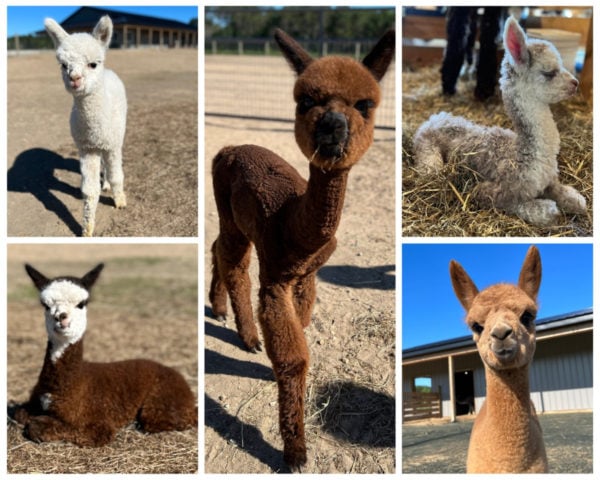
Know What Kind of Alpaca You’re Breeding For
Before jumping into buying alpacas and breeding, it’s good to know what kind of alpaca you’re trying to produce. This basically breaks down into alpacas for show, alpacas for breeding (on your farm or others), quality alpacas for fiber, and low-quality alpacas for pets.
- Show Quality Alpacas – An alpaca worthy of showing will be in the top percentage of alpacas. They’ll have exceptional fiber characteristics, strong conformation (body structure), a strong phenotype (visual presentation), strong genotype (genetics), and a lineage of champions. You’ll find these alpacas through proven alpaca breeders, reviewing EPD results, sifting through histograms, and looking at ARI certificates for known producers. If you want to produce show quality alpacas, you need to budget for purchasing a starter herd that is at the top of its game.
- Breeding Farms – Not everyone wants to go to alpaca shows and that’s okay. You can still be a profitable farm without competing at the show level. Some farms just want to breed and produce high quality alpacas that will advance the industry’s quality and fiber usage. If this is you, you’ll want to review all the same elements as a show alpaca, but you’ll have a bit lower standards. Instead of requiring a 1% EPD rating, you might opt for a solid EPD rating. The nice part about starting at this level is with the right starter herd you can breed up to show quality if you shift gears.
- Fiber Farms – A good fiber alpaca will have low micron count, excellent staple length, good density, and solid uniformity. It will produce quality fiber that can be used in commercial or cottage mill processing. It doesn’t necessarily need that perfect show conformation, oodles of crimp, or an amazing pedigree, but it does need to produce quality fiber that is consistent. For farms wanting to get their feet wet, this is an excellent place to start. Most farms that go this route are small and they only produce what they’ll be using to create fiber for their own usage.
- Pet Alpacas – If you’re reading this, please take note of this more than anything else in this article – don’t set your farm’s breeding program to breed for low quality alpaca pets. The industry has enough pet alpacas in it already and we don’t need to proactively produce more. You’ll be doing a disservice to the industry and alpacas if you make this your quest. Older females and lower quality males make excellent pets and there is no need to try and make more. Alpaca pets naturally occur as a fallout of existing higher end breeding programs or as they age out of breeding and fiber production.
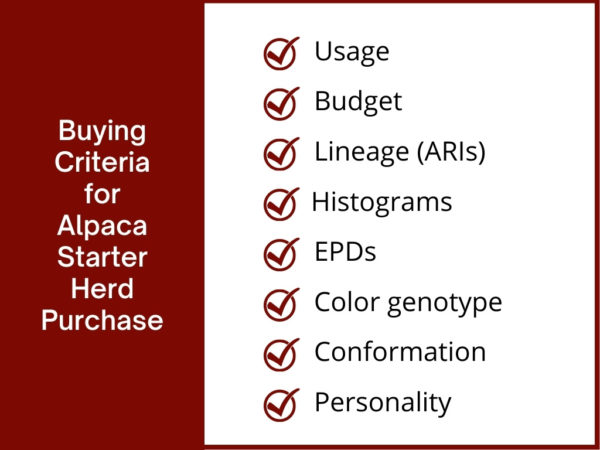
Once you’ve decided on the type of alpacas you want to produce, focus on buying a starter herd that matches your goals. Don’t over-buy or under-buy based on emotion, location, or convenience.
And for the love of alpacas and all that is good, only buy from experienced breeders who have their alpacas registered with the Alpaca Owners Association and who follow industry best practices. Do not buy from a backyard breeder on Craig’s List who has two unregistered alpacas mixed in with goats, sheep, horses, etc.
Understand the Economics of Alpacas
I encourage any future alpaca buyers to create a business plan and calculate out potential ROI (return on investment). This way they will know if investing in alpacas is right for their farm. It’s hard to do this if you’ve never raised alpacas before, so let’s walk through an example of buying and selling alpacas.
Starter Herd Purchase Price
$15,000 for 3 bred females
$10,000 for 2 herdsires
$1,000 for 1 male companion
Total investment = $26,000
You can view our alpacas for sale to get a feel for pricing.
Revenue Generated From Our Starter Herd
- Revenue in Year 1 – Let’s assume in the first year of breeding we produce three lovely ladies. We sell these ladies at a price of $3,000 each, which puts first-year revenue at $9,000.
- Revenue in Year 2 – The following year we produce three boys who are not herdsire quality, so they sell for a price of $1,000 each. Our first and second years’ revenue would now be $12,000, which is great, but we haven’t paid back our full investment yet.
- Revenue in Year 3 – In the third year, we have a mix of two girls and one boy. The boy is a solid fiber male, one girl is a solid breeder, and the other girl looks like a show girl. Those alpacas might sell at $1,000, $3,000, and $5,000 each. This puts year three at a revenue amount of $9,000, with total revenue of $21,000, and it leaves us with $5,000 left to obtain ROI.
- Revenue in Year 4 – In year four we lose a baby and only produce one breeder female and one fiber boy. Our sales this year are $4,000, with total revenue to date of $25,000, and we’ve almost reached a full return on our investment.
- Revenue in Year 5+ – Since we’ll easily recoup our original investment in year five, year five and on become profit. Alpacas can breed until their mid-teens, so you have lots of years of profits ahead.
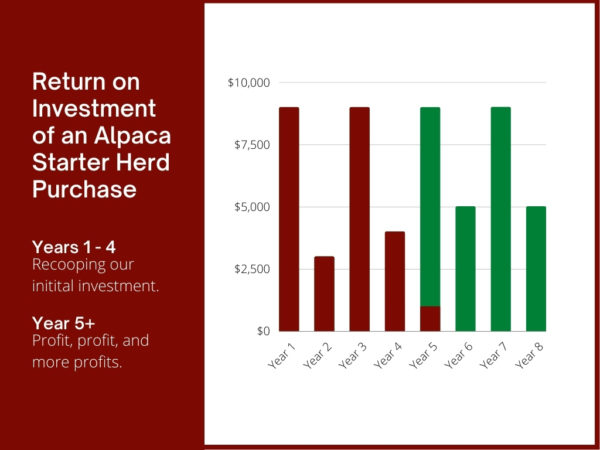
You might be wondering about expenses related to hay, shearing, and medical bills. Well, these all exist, and they do cost money, but they should be more than offset by product sales made from the fiber of the original herd and the tax deduction you’ll receive for your initial investment and annual expenses.
What? You can save money on taxes? Yes, yes you can. Your initial alpaca purchase (the livestock) will be amortized, and you’ll get a tax deduction for each year moving forward that is on the tax depreciation schedule (the timeframe is set by your farm savvy CPA). Any expenses for hay, shearing, ARI registrations, and medical bills are straight deductions in the year incurred.
Since an alpaca can live and breed for a good 12-14 years (and even longer in some cases), you should have plenty of money to make a handsome profit from your original investment.
That is a quick overview of the economics of breeding alpacas! When done right, it’s a beautiful business.
Familiarize Yourself With the Basics of Breeding
There are a lot of people who assume alpacas are bred and cared for like the family dog or other livestock animals. This is a false assumption. My beloved alpacas are unique, and they are not like other animals. You cannot go into this process thinking you’ll breed alpacas like you’d be breeding a Labradoodle.
If you want to successfully breed and raise alpacas, you need to know all about their nuances. These include both biological and emotional elements. I’ll run through my favorite alpaca tidbits on the process of breeding.
- Female Age of Maturity – While female alpacas are generally sexually mature between 10-14 months of age, alpaca experts recommend holding breeding until the female reaches 15-18 months and a minimum of 90 pounds. A female alpaca’s ovarian activity doesn’t reach its fullest potential until about 17 months of age.
- Male Age of Maturity – Male alpacas can begin breeding and successfully impregnating females between 13 and 24 months, although late bloomers won’t be ready until 24 to 35 months. This was demonstrated on our farm with Daredevil and Romeo. Daredevil was ready, eager, and very capable at less than two years of age. Romeo couldn’t figure things out until he was much, much older.
- Induced Ovulation – Unlike human females, alpacas do not have a “monthly cycle” and they begin the ovulation process when mating starts. Ovulation typically occurs 24 to 48 hours after mating.
- Alpaca Penis – The alpaca penis has often been referred to as a corkscrew. It is long and thin with a slight curve. The corkscrew portion is a tip that is used to dilate the cervix and enter the uterus during breeding. While this physical property works great for breeding the ladies, it can cause significant damage (and death) to a female alpaca if breeding takes place too often. It is for this reason that we keep males and females completely segregated. Castrating a male (also called a gelding) does not change the shape of the penis or the ability to enter a female. A gelded male can still do significant harm to its female counterpart.
- Cushing – If the female alpaca is interested in breeding, she’ll lay down and allow the male to mount her. We refer to this position as cushing. If the alpaca has no interest, she’ll run away and avoid all interaction.
- Orgling – When you bring an experienced male into the female pen, he’ll puff his chest out, prance around, and start orgling. The orgling sound is hard to describe, but once you hear it, you won’t forget it. Leviticus is our resident stud, and all the ladies love him. One of the main reasons the ladies love him is because he is the master of orgling. He starts his music, the ladies drop, and a baby is made. Easy peasy.
- Halter vs. Pasture Breeding – Smaller farms like ours will halter breed, which means we will bring a male on a halter to the female pen and point him towards the lady we’d like him to breed. We match males and females up based on their color genotype, fiber, conformation, genetics, and lineage. Once the male is done, we bring him back to his pen. Pasture breeding is very different and will occur on large farms with hundreds of animals. When pasture breeding you leave a male in with a large group of females for about a month. He’ll go through the ladies and do his work until all ladies are pregnant. An experienced male is smart enough to know who is open (available) and who is pregnant and needs to be left alone.
- Drive By Breeding – A drive by breeding occurs when you’re using someone else’s male to breed. You’ll load up the male or the female and drive them to the destination farm where the breeding will take place. It’s pretty easy to do a drive by breeding with males and this is especially true if they’ve done them before. The boys know they’re headed to a date and they know to perform once they get there. The ladies are different. Some ladies are perfectly agreeable with drive by mating. Others are just too stressed and it won’t work. Our Faith is one of these girls. We tried multiple drive by attempts with her and I finally called it quits until we could breed Faith at our farm and on her terms. As soon as we switched to this process, Faith was pregnant.
- The Alpaca Spit Test – If the female is already pregnant, she’ll let the male know by throwing some aggressive spit his way. Kalypso, an experienced female breeder, will literally run to the male, throw a huge spit at him, and then leave. We refer to this behavior as a positive spit test. And as crazy as it may sound, this spit test is about 80-90% accurate.
- Alpaca Gestation Period – A female alpaca is pregnant for about 11.5 months. Data has shown the average length of time ranges between 335 and 355 days with reported pregnancies going out as far as 380 to 400 days. Our personal record is Kalista at a whopping 370 days. It seems the longer the gestation period, the grabbier the female. And who could blame them after being pregnant for about a year?!
As you can see from the above information nuggets, alpacas are unique and they are not like other livestock when it comes to their anatomy, body function, and breeding practices. You have to take the time to learn their nuances to best care for them and their offspring.
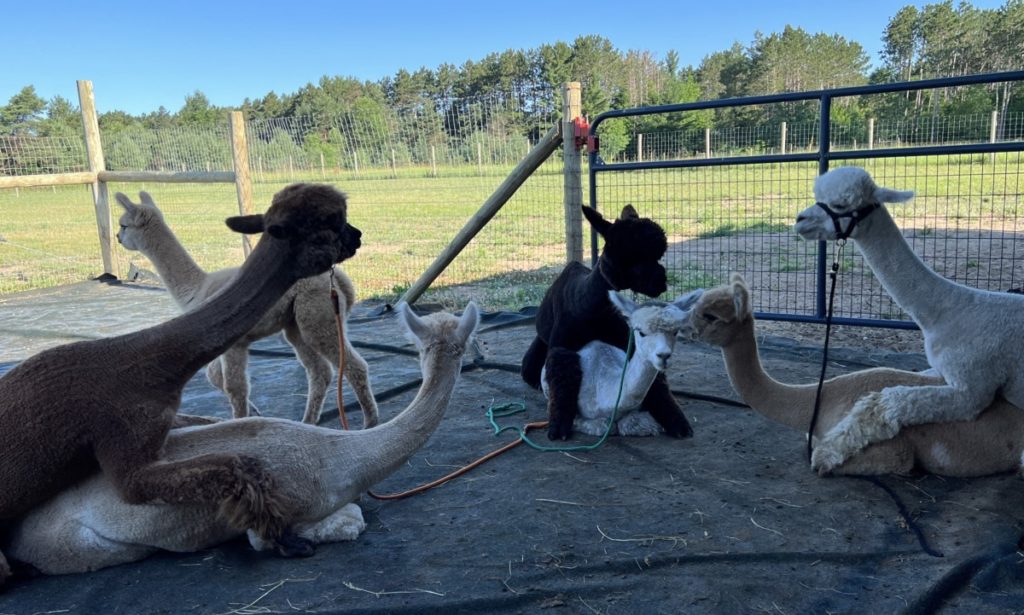
Remember That Every Alpaca is Different
Over the last few years of breeding alpacas, we’ve also learned that each alpaca is different. You cannot expect to breed the entire herd in the same manner. You might be able to do so with other livestock, but not with these lovely creatures. They are too smart and they have way too much personality to expect generic behavior.
If you want to maximize your breeding possibilities, you need to know your alpacas intimately and you need to breed them according to their unique physical and emotional traits.
Examples of different alpaca breeding styles:
- Faith – This lady came to us via a request from the 4-H. She didn’t have a stellar home and it took me months to gain her trust. She must have a low stress, calm environment to breed. If it isn’t, she either won’t allow the breeding or it won’t take because she’ll have an elevated stress level.
- Sherry Ann – This lady is a show quality alpaca that comes from a stellar pedigree, so we’re eager to breed her. Unfortunately, it is time for her to breed and she is physically ready, but she isn’t mature enough emotionally. This means a spring breeding won’t happen and we need to wait until fall to see if she has matured enough to have an interest level that will support a successful date.
- Diva – This young lady is another show girl. She has amazing fiber, she’s cute as a button, and we can’t wait to have her breed. While she is going to be old enough to breed, her weight isn’t at the level it needs to be. We have to wait to breed her.
- Lilly Grace – This young lady is old enough, large enough, and mature enough to breed. She just reached the age of maturity, and she lets us know it by waiting at the fence line, staring at all the men across the farm.
- Expressa and Lilly Grace – Both these ladies are rollers. Instead of staying in a cushed position the entire time they breed, both ladies tend to roll on their side. For a pregnancy to take, we need to help the male accommodate this strange shift in position.
- Romeo – This guy is one of our herdsires. He has fabulous fiber, and we were excited to get him breeding. Sadly, he just couldn’t quite figure out the breeding process at first. He knew he liked the girls, but for some reason, he didn’t understand the concept of putting his butt down. We would sit and watch him as he tried to figure out what to do with all his manhood. Eventually, he figured it out and he has multiple babies as a result. He was totally fine with all the trial and error, but my husband, not so much. It took Romeo a good year of breeding attempts to know what to do and we had to give him the gift of time to figure it out.
- Leviticus – Leviticus is our resident stud who brings all the macho and energy you could ask for. But this comes with a cost. When we halter breed, my husband Jason has to manage him. At 5’9 I’m not large enough to manage Leviticus during breeding. He isn’t mean, but he is active. The boy is just very excited when it’s date time and his energy level is more than I can manage. So Jason takes care of him, while I opt for our calmer males Occult and Coalition.
- Ariana and Most of the Ladies – The majority of the ladies tend to be “one and done” females. This means we breed them once and they are pregnant. Alpacas tend to be eager breeders, and when this is the case, pregnancy happens quickly.
- Kalista – Now let’s talk about the length of pregnancy. This year Miss Kalista delivered her daughter at 370 days. Think through that number. Kalista was pregnant for over a full year. She was over her pregnancy and so were we. Finally, little Sophie arrived, and she was perfect. Some ladies like to deliver early, some late. The strange part is the ladies control the timing of their births by days and even down to the hour.
Use Data to Match Your Breeding Pairs
When we have people contact us for alpacas to buy and breed, the first thing we ask is what their herd is lacking or we inquire about their breeding objectives. A lot of people think we’re kind of crazy for asking these questions, but we do it to help make sure the farms are breeding for what their herd needs.
When we are ready to start the breeding season our family sits down together to discuss our objectives for the farm, the herd as a whole, and individual alpaca. Do we need to improve fineness, density, staple length, crimp, and uniformity or would we like to work on shifting the colors produced?
Once we know what we need to improve, we match that up to specific alpacas. For example, Dolly has great fineness and amazing staple length, but she lacks uniformity. Coalition is known for his superb uniformity. So a natural match is to pair these two together so Dolly can improve the uniformity, while not compromising her staple length or fineness.
Our farm has also been working on using color genotyping to better manage the color outcomes of our entire herd of alpacas. This genotype testing process tells us the exact color background of each alpaca and it allows us to calculate percentages of color outcomes for each breeding pair. My husband has not been wrong yet and he has projected each color outcome for our births. His knowledge of science is super cool and slightly spooky all at the same time. It’s been a game changer and it has allowed us to shift our breeding program from producing all the colors to being highly focused on greys and blacks (which are his favorite colors).
In our industry we are blessed with lots of data and data helps us make better breeding decisions. We have EPDs and histograms, as well as an alpaca’s full lineage available via industry ARIs.
Here are some data points to consider for deciding which alpacas to breed:
- Lineage – By using the national association’s alpaca database, we know an alpaca’s parents, grandparents, and pretty much any of their ancestors since the time they arrived in the United States of America. This data is available because the AOA registry holds data for over 280,000 alpacas. Alpaca registration at the AOA validates the alpacas’ pedigree and tracks the bloodline through DNA testing, which AOA has conducted since 1998. It’s an amazing tool and it is available to all association members.
- Histogram – A histogram provides graphical data on specific traits like fineness, crimp, and density. We send our fiber to a testing facility each year, so we know the properties of each alpaca’s fleece. This data helps us know what to use the fiber for, but it also greatly helps us know how to breed that alpaca.
- EPDs – An EPD is a set of data that is generated from the same testing we use for histogram data. EPDs are predictions about an alpaca’s ability to pass on a specific trait (like fineness) to its offspring. EPDs are calculated using pedigree information, including relationships amongst all animals in a population, and trait performance data (fiber diameter, fleece weight, etc.) on those animals. The national association will then use this data to rank the alpaca against other alpacas across the nation.
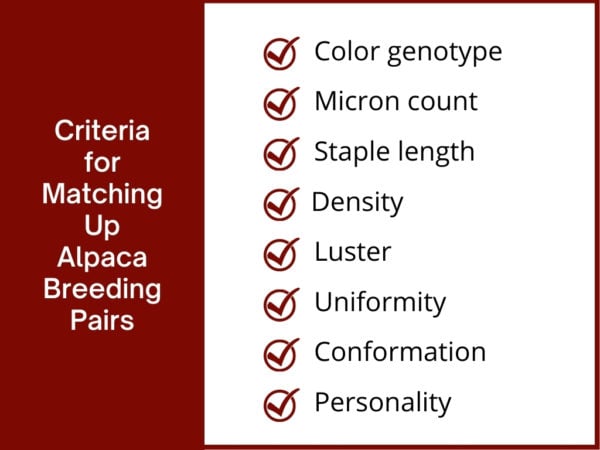
Our goal as an industry is to improve the quality of the alpacas produced. This is good for the alpacas, the farmers, the usage of the fiber, and for the viability of the alpaca industry. If we use the data available, we can and will improve the industry’s quality, revenue generation, and health of the animals. Stated another way, you should be using data to properly breed alpacas and to make sure your breeding pairs improve the species.
Learn more about the AOA’s Breeding Standards for Huacya Alpacas.
A note on inbreeding – The AOA offers data that can help calculate the inbreeding of potential mates and of individual alpacas. They offer this information to protect our industry from the horror stories we’ve all heard of in puppy mills that produce inbred dogs. By registering your alpacas with the national association you help protect our industry from inbreeding.
Feeling a Bit Overwhelmed?
If you’ve stayed with me and you’re now confirming that you do feel overwhelmed, I’m actually really happy.
I’m happy not because I want your head full, but because I want you to understand that breeding alpacas takes education, patience, and work. I want you to see your decisions can greatly influence the outcome in both positive and negative ways.
When you decide to purchase an alpaca starter herd for breeding purposes, you need to understand that this decision comes with a great deal of responsibility. You need to know what you’re doing, and you need to have a plan for when things go wrong.
Read about our first alpaca birth experience, which of course, came with difficulties. And don’t worry, it has a happy ending. Our baby Teddy is now living his best life in South Carolina.
My husband and I learn something new every day and you will too. I don’t expect you to know everything, but I do expect you to take the time to learn as much as you can and to always work to improve your knowledge.
That learning will and should continue for as long as you own this magical animal.
Additional Resources
Here are my recommended books for advancing your knowledge of alpaca care and breeding best practices:
- The Art & Science of Alpaca Judging – If you plan on breeding alpacas for show, this book is a must-read. It will teach you about conformation, fleece quality, and genetics. It will help prepare you to review high-quality alpacas for purchase and what you need to think about in breeding for alpacas shows.
- Alpaca Field Manual by C. Norman Evans – This book is a must-have book for alpaca owners. It covers key elements of ongoing care, breeding, birthing, immunizations, and parasites.
- Llama and Alpaca Neonatal Care – This is a great book for reference while birthing. I have pulled it out many times when things start to go sideways.
- Neonatal Care for Camelids – This book is a great tool to improve your understanding of reproduction and neonatal care of llamas and alpacas. The authors have over 50 years of combined experience with the reproduction and health care of camelids.
Remember, it is your responsibility to breed responsibly. You have the welfare of many wonderful alpacas in your care and you need to take that responsibility to heart.

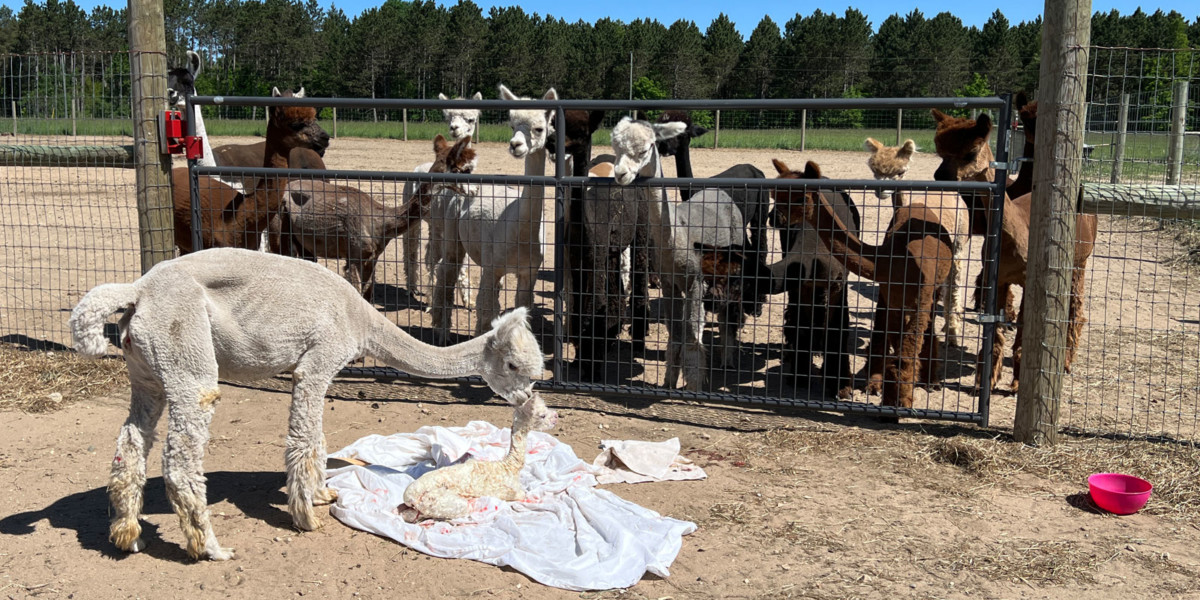
Hi Rebecca,
Can you tell me if I can keep three male alpacas together in the same paddock ?? One is our “Alfa” male , one is 3 yr old male and one is a two month old male cria
that just lost its Mom …. Thanking you in advance for any information !!
Kind regards,
Lisa
Lisa there is an extremely high probability of the older boys killing the cria. And if they don’t do it, I would suspect the stress of the move would cause a large parasite bloom and compromise the health of the cria.
The cria should stay with the female herd and other crias until about six months of age. This way the other momma’s could provide some herd behavior training and he’d have someone to play with. In a perfect world, a female would take him under her wing to mother. We have had this happen. Jalapena served as the mother to Patrick in all aspects outside of milk production.
Make sure this cria has ample access to grain pellets. He will need the extra supplements since he is not receiving milk.
I have a two year old female that was breed and born here. We have nine Suri Alpacas. I want to breed Willow but my only Studs are either her father or two half siblings. One they have the same mother different fathers and the other boy, same fathers different mothers. All AOA Registered. Can I use one of my in tack males to breed her? What is the difference in In Line Breeding and inbreeding.
You cannot breed alpacas that are so closely related. That is inbreeding and it will cause significant health issues and abnormalities.
Inbreeding refers to breeding father to daughter, mother to son, or brother to sister. This is what you are referring to above. Line breeding involves breeding distant relatives to enhance certain characteristics. They are very different.
We have encountered people who have purchased or adopted inbred alpacas. It is more sad than I can explain in a comment. The outcome is never good.
I’d recommend purchasing a new herdsire who isn’t related or buying a “drive by” breeding from a farm near you.
Rebecca ~> I’m JoAnn Poulton from Heaven and Earth Alpaca Farm in Hudson,Ohio. This is one of the best comprehensive ~ informative ~ heartfelt alpaca document I have read in my twelve years of farming.
I think we should meet. Will contact you. JP
Hi. We have a 17 year old male who is very docile. He is being attacked by the alpha male. I would like to move the nice one in with the females and gelded males, before the alpha kills him. My husband is concerned he might impregnate a female. He’s also afraid if we have him gelded at such an old age he would die from the gelding. Can a male still impregnate at age 17 and/or is having him dangerous to him?
There is a lot of misinformation about this in the alpaca industry which leads to your discussion with your husband.
The concern is not just creating a baby. The concern is that a male (even a gelded one) will mount the female and chew away at her insides until she has permanent internal damage.
An alpaca penis is like a long straw with a corkscrew end. While a female can breed with this, breeding can only be done in limited amounts. Frequent mounting and intercourse will damage the female and it can produce enough damage to kill the female.
Gelding an alpaca only takes away the ability to produce offspring. It does not prevent an erection and intercourse. Just like a human, a gelded male can skill mount, can skill harm, and can still kill a female.
So baby-making aside, just don’t do it. And if you have males and females together now, remove them.
We never place males and females together and I will not sell a female to a farm that will. I state that so you can see the severity of the situation and that placing males and females together is a risk I am not willing to take.
If you have females with gelded males you are taking significant risks with your female’s health. They should be removed.